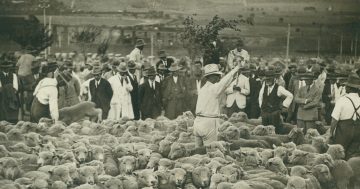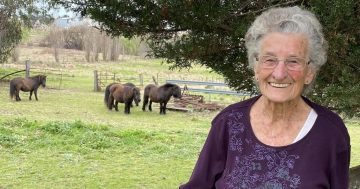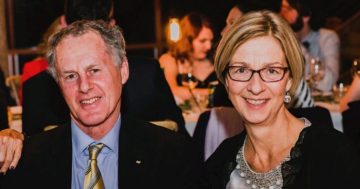
Tony Dowe with his daughter Kate Dobosz and granddaughter Mikayla. His time in Goulburn left a lasting impression among the rural community. Photo: Kate Dobosz.
Thirty-four years after an auction he conducted achieved a world record price at the Dubbo ram sales, Tony Dowe can still recite his pitch word-for-word.
Over 20 years he perfected his auctioneering skills in Goulburn. At 87 years old, his voice is as crisp and concise as it was in 1988 when the record-breaking ram fetched almost 10 times what its owners had expected.
The auction was over in 90 seconds.
“Is there $35,000 to start him?” Tony had called in a loud urgent voice.
“Yes!” cried a bidder from the opposite side of the pen holding the ram.
“$35 I’ve got,” yelled Tony.
“$35, $35…”
“$40,000!” came another shout and away the bidders went like a bushfire.
When the price reached $50,000, Tony jumped to calling for $10,000 bids. At $100,000 he jumped to $25,000 bids. Eight bids followed, taking the price to $300,000.
Then momentum slowed. But the gun auctioneer wasn’t quite finished with the two syndicates from NSW and Queensland still in the bidding.
“Look! I’ll take a short one,” he said, then called three more bids of $10,000 before knocking down the ram for $330,000, a world record.
In Goulburn from 1961 to 1984, Tony once asked a rival auctioneer and friend Peter Norrie from Dalgety’s what it took to be a top auctioneer.
“No brains and tonnes of guts,” Peter had said, laughing.
Tony had the brains, courage and understanding of livestock and their owners. His eye for that record ram’s deep-crimping wool, beautiful definition and superb structure was bang on the money, too.
But all this knowledge would not amount to much without that voice. It was strong, compelling and full of confidence and conviction.
“If you can’t project your voice, you are no good,” Tony said.
“And you need a personality because again, my comment to a number of people I have trained, you have to remember you are not selling that article in front of you; you are selling yourself.”
It’s the auctioneer’s job to captivate his audience.
“The ability for an audience to maintain interest is in direct correlation to the numbness in their backsides,” he said.
“If they are sitting there bored stiff, you don’t get a positive reaction from them.”
Born in Tamworth from where he began his career in livestock, he decided almost immediately after arriving in Goulburn that he hated the place and wanted to go home. But he persevered.
One day, he took a phone call from another agent about Sir Walter Merriman’s inaugural sale of stud ewes at the Yass showground.
“Sir Walter said ‘use that young fella from Goulburn; I think he’s as good as any and better than most’,” Tony said.
“I was very, very raw at that time; the Merrimans have been incredibly good to me. You get a couple of runs like that, a couple of wins like that, reputation gets reputation.”
Sheep studs from the north and south of NSW were quick to enlist Tony, yet he preferred cattle and his peers in Goulburn rated him even higher with cattle than with sheep.
In 1974 he was invited to sell at the World Charolais convention in Dublin. Auctioneers were from Europe and America and he found the Irish painfully slow, taking an hour to sell 12 head of cattle when he was a “one every 90 seconds man”.
“Momentum is important,” he said.
“So is knowledge of the article you are selling because you need to be very familiar with the market trends at the time. It’s no good asking $10,000 for a good bull if it’s not a good bull; you have to come back to a figure that is appropriate.”
Selling at up to 150 sales a year, much of Tony’s time was spent studying each auction’s catalogue.
“You talk about stud stock EBVs (Estimate of Breed Values) on Shorthorn cattle a lot different to those in Hereford cattle and a lot different again in Angus cattle because they don’t come from the same base. So you’ve got to know your product,” he said.
Over three decades of selling at Sydney’s Royal Easter Show, he achieved many top prices.
In 1984 he told Elders management he felt he had won all the business he was going to in Goulburn and asked them to look for opportunities for him elsewhere. Sooner than he was expecting, he found himself back in Tamworth integrating three companies and overseeing 20 branches from there to the Queensland border.
After two years he became NSW stud stock manager and then national stud stock manager. He retired in November 2005, but travel plans were shelved when his wife Dimity suffered a stroke and was confined to a wheelchair. She died nine years ago.
Today Tony continues watching markets, attending sales and buying bulls for clients. An auction somewhere always beckons.











